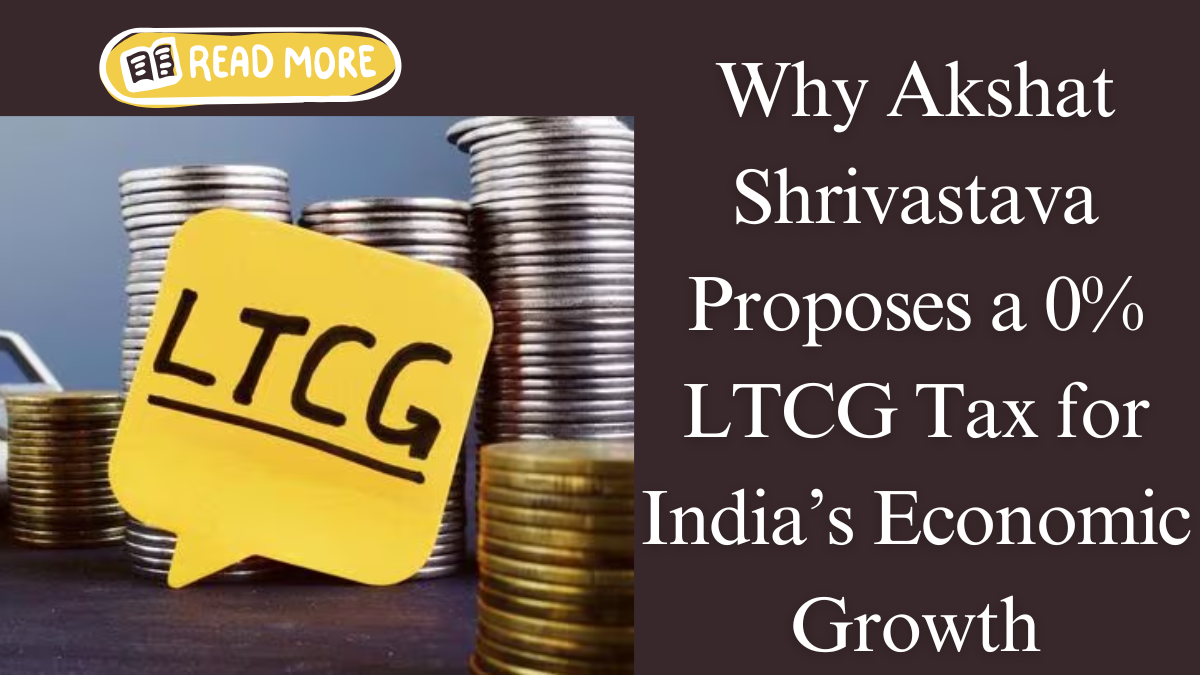India’s tax system has faced its share of scrutiny, particularly when it comes to Long-Term Capital Gains (LTCG) tax. The current framework charges a 10% tax on gains from the sale of equities or equity-related assets, which many investors argue is a burden on their returns. Finance expert Akshat Shrivastava has recently proposed a bold idea: a 0% LTCG tax in India. This article delves into Shrivastava’s argument and the broader implications of such a move.

Current Scenario: High LTCG Tax in India
India currently levies a 10% LTCG tax on capital gains exceeding ₹1 lakh from the sale of stocks or equity-related investments held for more than one year. While the tax rate is lower than in many countries, it still discourages long-term investment and creates a drag on potential returns. Critics, like Shrivastava, believe this tax discourages the long-term investment culture that is vital for India’s economic growth.
International Comparison: Sweden’s 30% Capital Gains Tax
Shrivastava brings up an interesting comparison: in Sweden, the capital gains tax stands at a steep 30%. While this figure is significantly higher than India’s, there’s a key difference. In Sweden, taxpayers receive high-quality public services such as universal healthcare, well-funded education systems, and robust infrastructure, making the higher tax rate more justifiable. Shrivastava argues that India’s public services do not provide the same value in return, and therefore, the 10% LTCG tax should be reconsidered.
The Case for 0% LTCG Tax in India
Shrivastava’s main argument for a 0% LTCG tax focuses on the economic incentives it would create for long-term investors. By removing the LTCG tax, the government could encourage more citizens to invest in the stock market and other long-term assets, thus fostering economic growth.
Key Points of Shrivastava’s Argument:
- Encouraging Investment: Eliminating the LTCG tax would make it easier for individuals to build long-term investment portfolios, fostering a more active financial market.
- Capital Formation: With fewer taxes levied on capital gains, more individuals will be encouraged to invest in critical sectors like infrastructure and technology, fueling capital formation.
- More Jobs and Economic Activity: Increased long-term investments would naturally lead to greater economic activity, potentially leading to job creation across various sectors.
- Tax Efficiency: Shrivastava believes that a 0% LTCG tax would simplify India’s tax structure, reduce tax evasion, and improve compliance.
The Need for Better Public Services
A central theme in Shrivastava’s argument is the value taxpayers receive for the taxes they pay. In countries like Sweden, taxpayers accept high capital gains taxes because they receive top-tier services in return. Shrivastava argues that until India can offer comparable public services, a 0% LTCG tax would be a more equitable policy for investors, as they would be better incentivized to invest in India’s growth.
Challenges to Implementing 0% LTCG Tax
While Shrivastava’s proposal sounds promising, it is not without challenges.
- Loss of Tax Revenue: A 0% LTCG tax would result in a reduction in tax revenue in the short term, putting a strain on the government’s ability to fund various initiatives.
- Fiscal Impact: The government would need to explore alternative means of revenue generation, such as increasing corporate taxes or improving tax collection efficiency.
- Wealth Distribution Concerns: Some critics might argue that eliminating LTCG taxes could disproportionately benefit the wealthiest individuals, exacerbating income inequality. There may be concerns that high-net-worth individuals could use the tax exemption to further grow their wealth further, leaving the less privileged with a heavier tax burden.
Conclusion
Akshat Shrivastava’s proposal for a 0% LTCG tax is a bold challenge to India’s current tax system. He emphasizes that, unlike countries like Sweden, India does not provide sufficient value for the taxes its citizens pay. By eliminating the LTCG tax, Shrivastava believes that India could see a more robust economy with higher long-term investments.
However, such a drastic change would require careful consideration, especially in light of its potential fiscal impact and the need to ensure fairness across different income groups. Ultimately, Shrivastava’s suggestion may serve as a starting point for a much-needed debate about India’s tax policies, long-term investment strategies, and the broader fiscal landscape.
FAQs
What is the current LTCG tax in India?
The current Long-Term Capital Gains (LTCG) tax in India is set at 10% on capital gains exceeding ₹1 lakh from the sale of equities or equity-related investments held for more than one year.
Why does Akshat Shrivastava advocate for a 0% LTCG tax?
Shrivastava believes that eliminating the LTCG tax would encourage long-term investments, foster economic growth, and simplify the tax system, creating a more attractive environment for investors in India.
How does Sweden’s capital gains tax compare to India’s?
Sweden imposes a significantly higher capital gains tax at 30%. However, in return, Swedish taxpayers benefit from high-quality public services, making the higher tax rate more acceptable to its citizens.
What are the challenges of implementing a 0% LTCG tax in India?
The primary challenges include potential loss of tax revenue, the fiscal strain it could place on the government, and concerns over increasing income inequality, as wealthier individuals may benefit the most from such a policy change.
Click here to learn more.
Pari is a passionate writer known for captivating stories that blend imagination and reality. Inspired by travel, history, and everyday moments, Pari crafts narratives that resonate deeply with readers.
